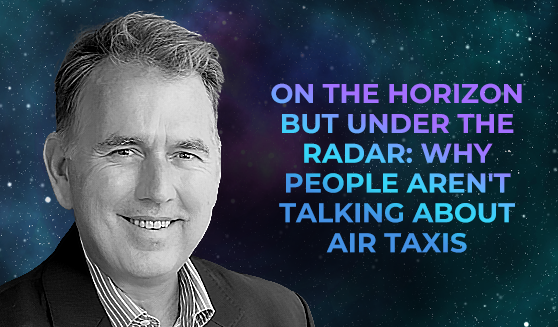
On the horizon but under the radar: why people aren’t talking about air taxis

If the world was on the cusp of a new form of air travel which would allow us to fly across cities and towns quickly and easily and with minimal impact on the environment, you’d think everyone would be talking about it – right?
Wrong. Because we are very close to electric air taxis (drones that can carry up to six passengers, also known as eVTOLs) becoming a reality; and yet, not many people have heard of them. Skyportz is one of the companies developing infrastructure to support electric air travel, with vertiports that will enable access to drones in key transport hub areas.
We asked Clem Newton-Brown (CEO at Skyportz) why people aren’t talking about air taxis, and he said:
“We do not have any aircraft flying commercially yet so it is really only those with an interest in this emerging industry who are seeking out the footage of test flights. For many people they need to actually see something new to believe it’s true – and I expect that when the first commercial services start somewhere in the world that there will be massive interest in the industry.”
See it to believe it
“A lot of people believe that it’s very sci-fi and too incredible to believe that these aircraft will exist soon,” Newton-Brown added. “However, compared to flying millions of people safely around the world at great speed in jets, I think that small, short-range electric aircraft are going to be very achievable for the companies working on prototypes.”
These aircraft are even more achievable when you take into account the level of investment being poured into urban air mobility by major aviation companies. In January 2022 Boeing invested USD $450 million into self-flying electric air taxi startup Wisk Aero, which formed in 2019 as a collaboration between Boeing and Kittyhawk. In May 2022 it was announced that new urban air mobility firm Eve Holding, founded and backed by Brazilian aerospace group Embraer, hit the New York Stock Exchange with a public listing that generated USD $377 million in proceeds. And Hyundai Motor Group (an early mover in the urban air mobility market) has committed to invest more than USD $10 billion by 2025 to accelerate innovation in this space.
So electric air taxis are coming. When they do arrive in the air above our heads, the governments that take the first steps will see a boom in investments that could boost regional economies. As Newton-Brown put it,
“Governments that are prepared to break the nexus between aviation and airports will be able to divert investment to their regions by simply making some tweaks to their rules and regulations around land use planning. Nowhere in the world has this happened yet.”
“Governments are cautious and it may not be until they can see and hear these new aircraft in the air that they’ll decide there is community support for this aviation revolution. The first jurisdiction that sets out clear new rules around vertiports in new locations will see massive investment flow.”
Who will be the first people to travel by electric air taxi?
According to Newton-Brown, eVTOLs will be “a whole new type of aviation that operates in a new space to existing aircraft. We will be opening the skies for everyday air travel to places people want to go.”
But before urban air mobility is so normal that everyone’s dropping into a vertiport to catch a drone to work, these new vehicles will have to find a way onto the scene that gives the general public a chance to see them in action, understand how they work, and feel confident that they’re a pretty good way to travel.
So, “initially it’ll be tourism uses, where people currently pay a premium for an experience. Helicopter operators will replace their fleets with clean, green and quiet electric air taxis for tourism uses.”
This is very much already in sight: “There are already established routes and landing sites for tourism uses so the industry can start there using existing infrastructure,” Newton-Brown pointed out. Then, when eVTOL prices decrease, they’ll be used for more general travel – as long as companies like Skyportz have been successful in building an efficient network of new vertiport sites.
We’re pretty excited for the day when we can head into the office in an electric air taxi, coffee in hand. But even more than that, we’re looking forward to learning more about urban air mobility infrastructure from Clem Newton-Brown at #LEAP23 – and you can join us if you register now.
